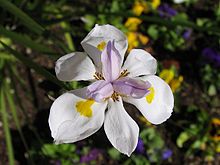- Dietes
-
Dietes 
Dietes grandiflora Scientific classification Kingdom: Plantae (unranked): Angiosperms (unranked): Monocots Order: Asparagales Family: Iridaceae Subfamily: Iridoideae Tribe: Irideae Genus: Dietes
Salisb. ex KlattType species Dietes compressa
(Linnaeus fil.) KlattSpecies See text.
Dietes is a genus of rhizomatous plants of the family Iridaceae. Common names include Fortnight lily, African iris, Morea or Moraea iris, Japanese iris and Butterfly iris, each of which may be used differently in different regions for one or more of the four species within the genus.
Most species are native to southern Africa, with one (Dietes robinsoniana) native to Lord Howe Island off the coast of Australia.
Contents
Taxonomic history
Dietes is probably the most primitive member of the Old World tribe Irideae. It shares characteristics of both Iris and the African genus Moraea and is most likely close to the ancestral stock that gave rise to these more specialized genera.[1]
These plants were formerly placed in the genus Moraea, but were reclassified because they are rhizomatous. Like Moraea, they differ from Iris in having flowers with six free tepals that are not joined into a tube at their bases.
Some references mention the species Dietes vegeta or D. vegeta variegata, springing from some confusion with Moraea vegata (which grows from a corm, not a rhizome). The name D. vegeta is commonly misapplied to both D. grandiflora or D. iridioides.
The genus name is derived from the Greek words di-, meaning "two", and etes, meaning "affinities".[2]
Species
Dietes comprises six species, five African and one remarkable disjunct on Lord Howe Island between Australia and New Zealand, D. robinsoniana. The South African D. bicolor appears more closely related to D. robinsoniana than to the other African species, and these two share several characters primitive in the genus. The remaining four African species include the wide-ranging D. iridioides, which extends from the southern Cape to Ethiopia, and three more localized eastern southern African species.
Species include:
- Dietes bicolor (Yellow Wild Iris, Peacock Flower, Butterfly Iris)
- Dietes grandiflora (Wild Iris, Large Wild Iris, Fairy Iris)
- Dietes iridioides (Wild Iris, African Iris, Cape Iris, Fortnight Lily, Morea Iris)
- Dietes robinsoniana (Wedding Lily)
D. bicolor has cream or yellow flowers. D. grandiflora and D. iridioides both have white flowers marked with yellow and violet, and appear similar in photographs, but they are quite different: those of grandiflora are much larger, last three days, and have dark spots at the base of the outer tepals, while those of iridioides are small, last only one day, and lack the spots. D. grandiflora is also a larger plant overall.
References
- ^ Goldblatt, P. (1981) Systematics, physiology and evolution of Dietes (Iridaceae). Annals of the Missouri Botanical Garden 68: 132-153
- ^ Manning, John; Goldblatt, Peter (2008). The Iris Family: Natural History & Classification. Portland, Oregon: Timber Press. pp. 204–207. ISBN 0-88192-897-6.
Bibliography
- Floridata: Dietes
- Goldblatt, P. (1981) Systematics, physiology and evolution of Dietes (Iridaceae). Annals of the Missouri Botanical Garden 68: 132-153.
Categories:- Iridaceae genera
Wikimedia Foundation. 2010.


